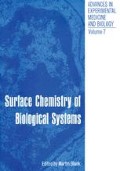Abstract
Mixtures of sphingomyelin and sulfatide or lecithin and sulfatide showed a titration capacity in the acid range that was greater than that of any of these lipids titrated alone. This is explained as the results of the ionic interaction of the sulfate and quaternary amine of neighboring molecules thus making the phosphate of the choline lipid available for titration.
This effect was greatest for sulfatide with sphingomyelin or with dipalmitoyl lecithin and decreased with egg lecithin and soybean lecithin. This order follows the increase in molecular cross-sectional area of the choline lipid and the increased separation of the charged groups of the mixed lipids. Incorporation of the neutral lipid, cerebroside, into sphingomyelin-su1fatide had little effect. Cholesterol, however, decreased the interaction of sulfatide with sphingomyelin or lecithin. This probably resulted from the separation of the charged lipids by the molecules of cholesterol. These data point to an intermolecular ionic linkage of choline lipids with anionic compounds in lipid membrane systems. The absence of any effect of cholesterol on the titration of choline lipids alone supports the view that lecithin and sphingomyelin without acidic components exist as dipolar ions with intramolecular bonding.
The addition of salts to systems of sphingomyelin-sulfatide or lecithin-sulfatide at pH 4.0 gave a cation-proton exchange with K+ = Na+ > choline+.
Sodium dodecyl sulfate mixed with sphingomyelin or lecithin gave reactions similar to but less than those of sulfatide with these lipids.
Titrations were also performed on mixed dispersions of dipalmitoyl lecithin and sodium dicetyl phosphate. These systems showed that all the phosphate groups of the latter were available for titration and lends weight to the assumptions made in the interpretations of the systems containing sulfatide.
This work was supported by Multiple Sclerosis Grant 503A, U.S. Department of the Interior, Office of Saline Water Grant 14-01-0001-1277, and U.S. Public Health Service Grants NB 03356 and NB 01450.
Access this chapter
Tax calculation will be finalised at checkout
Purchases are for personal use only
Preview
Unable to display preview. Download preview PDF.
References
Abramson, M.B., and Katzman, R. (1968), Science, 161, 576.
Abramson, M.B., Colacicco, G., Curci, R., and Rapport, M.M. (1968), Biochemistry, 7, 1692.
Abramson, M.B., Katzman, R., Curci, R., and Wilson, C.E. (1967), Biochemistry, 6, 295.
Abramson, M.B., Norton, W.T., and Katzman, R. (1965), J. Biol. Chem., 240, 2389.
Bangham, A.D., Standish, M.M. and Watkins, J.C. (1965), J. Mol. Biol., 13, 238.
O’Brien, J.S. (1967), J. Theoret. Biol., 15, 307.
Parsegian, V.A. (1967), Science, 156, 939.
Pethica; B.A. (1965) In Surface Activity and the Microbiol Cell, Soc. Chem. Ind. (London) 19, p. 85.
Shah, D.O., and Schulman, J.H. (1967a), J. Colloid Interface Sci., 25, 107.
Shah, D.O., and Schulman, J.H. (1967b), Jour. Lipid Res., 8, 215.
Shah, D.O. and Schulman, J.H. (1967c), Biochim. Biophys. Acta, 135, 184.
Sundaralingam, M. (1968), Nature, 217, 35.
Author information
Authors and Affiliations
Editor information
Editors and Affiliations
Rights and permissions
Copyright information
© 1970 Plenum Press, New York
About this chapter
Cite this chapter
Abramson, M.B., Katzman, R. (1970). The Effect of Hydrocarbon Configuration and Cholesterol on Interactions of Choline Phospholipids with Sulfatide. In: Blank, M. (eds) Surface Chemistry of Biological Systems. Advances in Experimental Medicine and Biology, vol 7. Springer, Boston, MA. https://doi.org/10.1007/978-1-4615-9005-7_5
Download citation
DOI: https://doi.org/10.1007/978-1-4615-9005-7_5
Publisher Name: Springer, Boston, MA
Print ISBN: 978-1-4615-9007-1
Online ISBN: 978-1-4615-9005-7
eBook Packages: Springer Book Archive

